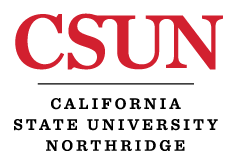Program: B.S., Kinesiology
Physical Education
Program Description
The word kinesiology comes from the Greek word kinesis, which means “to move.” Kinesiology is the study of the art and science of human movement. At CSUN, the discipline of kinesiology is dedicated to the study of human movement and physical activity as it relates to sport, dance and exercise.
This option provides the subject matter preparation required to earn a credential for teaching Physical Education in California public schools. Students seeking a teaching credential are advised to apply to the credential program as first-semester seniors. This is done through the Credential Office on campus. Completion of the Kinesiology major with Physical Education option, plus 31 units of professional education (including student teaching), are required for the Preliminary Credential. For details on the Single Subject Credential program, see the Credentials and Department of Secondary Education sections in this Catalog.
Program Requirements
A. Lower Division Prerequisite Courses (20 units)
1. Lower Division Science and Math Requirements (14 units)
Note: 8 of the 14 units double count in General Education and the major.
BIOL 101/L General Biology and Lab (3/1)
BIOL 211/212 Human Anatomy/Laboratory Studies in Human Anatomy (2/1)
BIOL 281 Human Physiology (3)
MATH 140 Introductory Statistics (4)
Note: Completion of BIOL 211 and BIOL 212 is prerequisite to enrollment in KIN 300. Completion of BIOL 281 is prerequisite to enrollment in KIN 346/L.
2. Lower Division Core (6 units)
KIN 200 Foundations of Kinesiology (3)
Kinesiology Movement Courses (3 units)
Choose one course from the following courses:
KIN 130A-133A, 151A Martial Arts Course (1)
Take the following courses:
KIN 242 Movement Forms: Basic Dance (1)
KIN 250SW Professional Activities: Swimming (1)
B. Upper Division Core (21 units)
KIN 300 Foundations and Analysis of Human Movement (3)
KIN 305 Historical and Philosophical Bases of Kinesiology (4)
KIN 306 Socio-Psychological Aspects of Physical Activity (3)
KIN 345/L Biomechanics and Lab (3/1)
KIN 346/L Physiology of Exercise and Lab (3/1)
KIN 377 Motor Learning and Control (3)
C. Physical Education Option Requirements (32 units)
1. Lower Division Required Courses (9 units)
KIN 271/L Fundamental Movement, Gymnastics and Rhythms and Lab (2/1)
KIN 272/L Nontraditional Games and Activities and Lab (2/1)
KIN 273/L Analysis and Application of Games and Sport and Lab (2/1)
2. Upper Division Required Courses (23 units)
KIN 315/L Analysis and Application of Multi-Cultural Dance Forms for Children and Adolescents and Lab (2/1)
KIN 335/L Health-Related Fitness in K-12 Physical Education and Lab (2/1)
KIN 347 Introduction to Adapted Physical Education (3)
KIN 371/L Physical Education Content Development for Children and Lab (2/1)
KIN 462/L Physical Education Content Development for Adolescents and Lab (2/1)
KIN 472/L Learner Assessment and Technology in K-12 Physical Education and Lab (2/1)
KIN 477 Motor Development (3)
KIN 478 Application of Motor Behavior Principles (2)
3. General Education (48 units)
Undergraduate students must complete 48 units of General Education as described in this Catalog. When students select BIOL 101/L (3/1), which is required in the major to satisfy 4 units of GE: Natural Sciences, and MATH 140 (4), which is required to satisfy 4 units of GE: Basic Skills-Mathematics, the GE total is reduced to 40 units. In selected options, there are additional “overlap” units for courses that count in meeting both major requirements and General Education requirements. Students should meet with a department advisor before selecting General Education courses. Failure to select overlapping courses may result in additional units in the major for selected options.
Total Units Required for the B.S. Degree: 120
Contact
Department of Kinesiology
Chair: Konstantinos Vrongistinos
Redwood Hall (RE) 250
(818) 677-3205
Student Learning Outcomes
The Department of Kinesiology is a learning-centered community that educates and inspires its students to understand and appreciate human movement for personal expression and wellness throughout the life span. In doing so, students and faculty work together to improve quality of life for themselves and their community. The department values and respects the spectrum of human diversity. An integrated approach to the teaching, learning and application of human movement provides opportunities and experiences to achieve the following learning outcomes:
- Apply an integrated kinesiological approach to encourage the adoption of healthy and physically active lifestyles, across diverse populations.
- Apply evidence-based practices to enhance the study of human movement.
- Demonstrate competent problem-solving strategies through intentional practices.
- Demonstrate knowledge of kinesthetic forms, processes and structures as they apply to the personal expression and culture of human movement.




